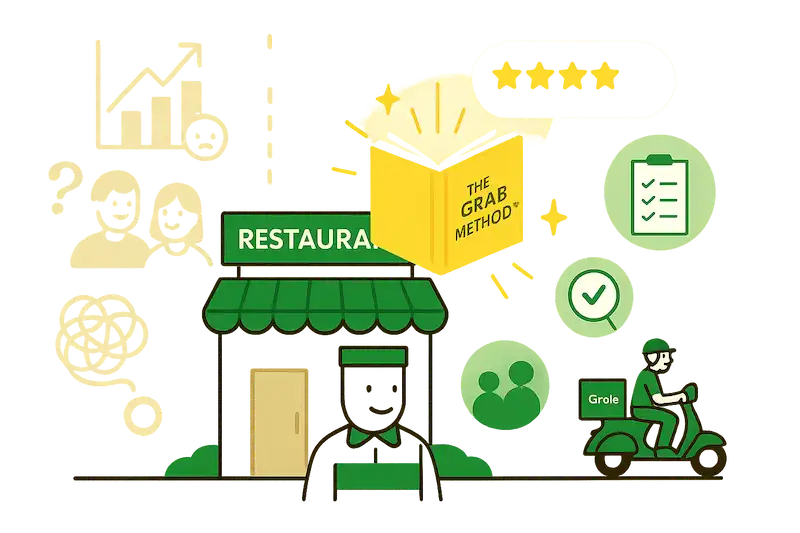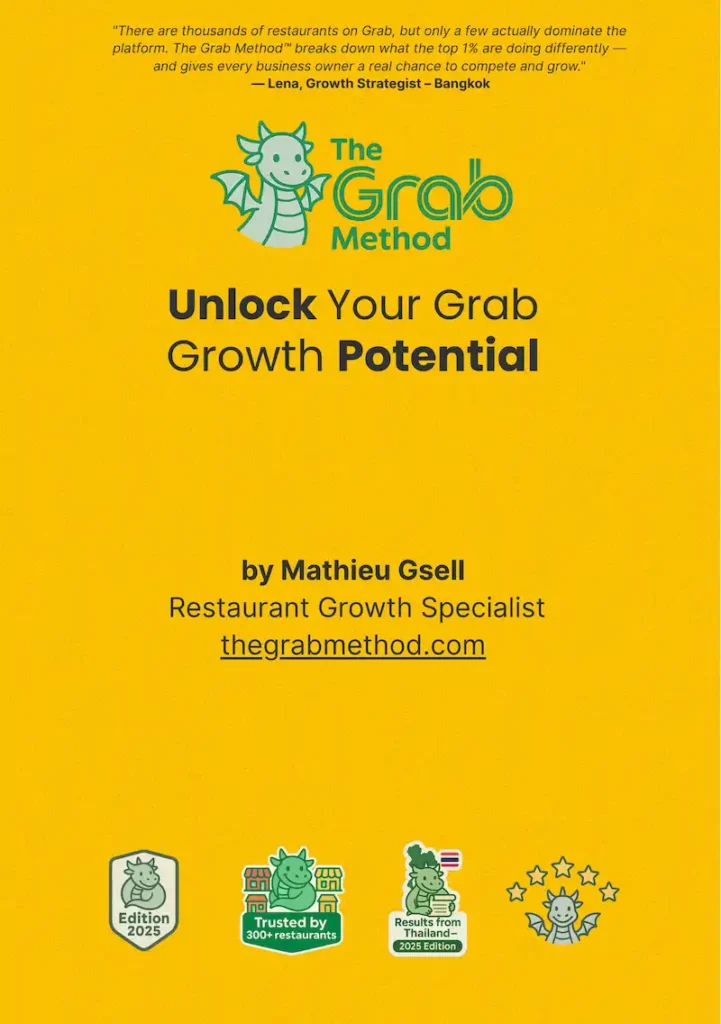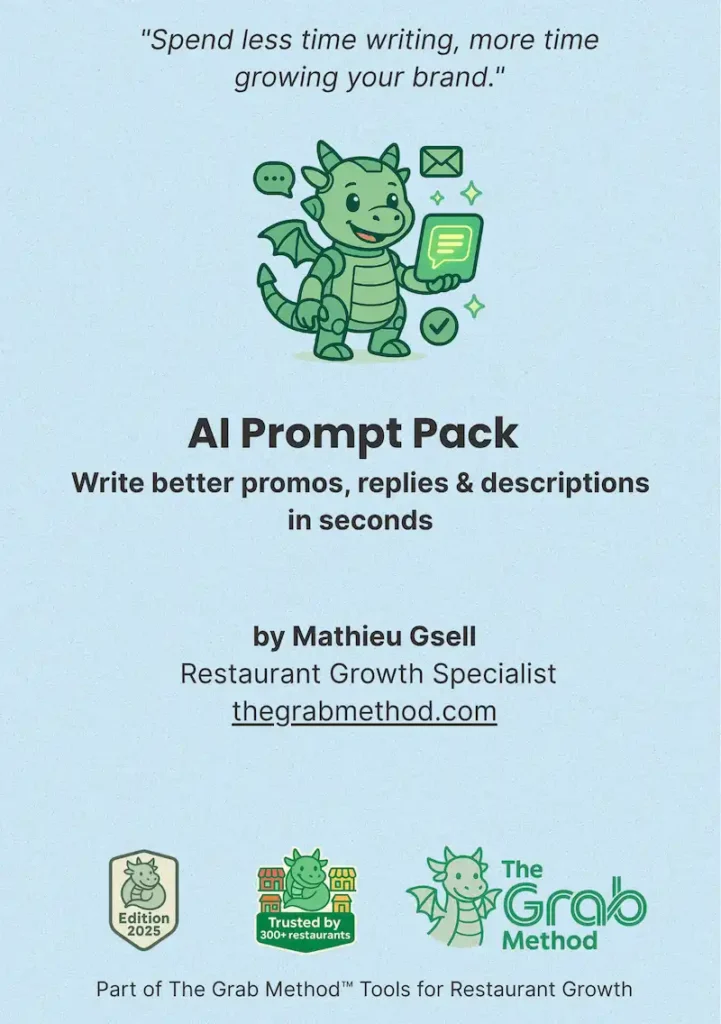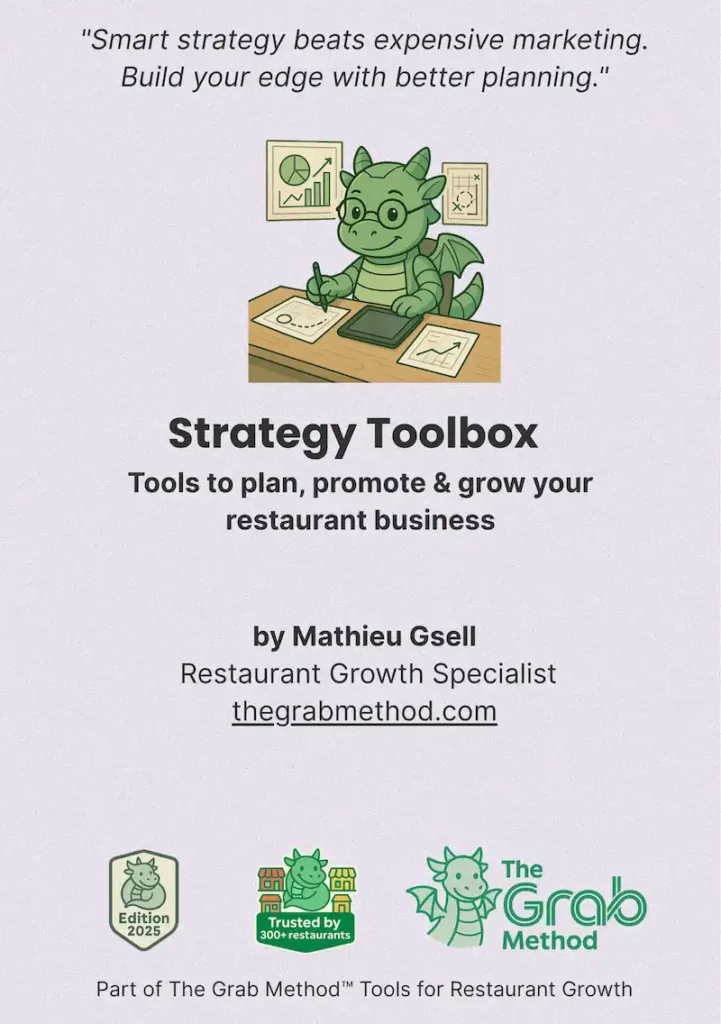📩 hello@thegrabmethod.com
🌐 thegrabmethod.com
Listing your restaurant on GrabFood is a great opportunity, but many eateries unknowingly make mistakes that hurt their performance on the platform. Whether you run a cloud kitchen, a small café, or a restaurant chain in Thailand or Singapore, avoiding these pitfalls can significantly boost your orders. From poor menu practices to ignoring key features, these missteps can leave your Grab presence stuck in the shadows.
What follows are the top 10 mistakes restaurants make on GrabFood – and more importantly, how you can avoid them. If you find your own listing guilty of any of these, don’t worry. We’ll show you the solution for each mistake, so you can turn things around and start getting more out of Grab.
One of the biggest errors is to treat GrabFood like a passive listing service. In reality, Grab uses an algorithm to rank restaurants in search results and carousels. If you ignore how this algorithm works, your restaurant might remain virtually invisible. Factors like how fast you accept orders, your ratings, and order volume all influence your ranking. Many restaurant owners don’t realize this and wonder why they’re stuck on page 5 of the app.
🛠 Solution: Learn what Grab’s algorithm values and optimize for it. For example, accepting orders quickly and reliably will improve your “order completion rate” – a key metric Grab tracks:contentReference[oaicite:7]{index=7}. Keep your preparation times accurate and as short as possible, maintain excellent customer ratings (more on that later), and engage customers with promotions. In short, treat Grab like you would SEO for Google: optimize your listing and service for the things the algorithm rewards. (Our Grab Method™ guide on ranking delves deep into these factors and how to master them.) By understanding and responding to Grab’s ranking factors, you’ll start climbing the ranks – meaning more visibility and more orders.
Restaurants that never run promotions are missing out on one of GrabFood’s most powerful tools. Grab loves to highlight eateries offering deals – think free delivery, percentage discounts, or “Buy 1 Get 1 Free” specials. If you have no promo offers, you lose out on being featured in the app’s special promo sections and you give customers no extra nudge to choose you. In the competitive Grab marketplace, no promotions often means fewer orders.
🛠 Solution: Always have at least one attractive promotion running. Even a small discount (e.g. 10% off, or a free drink with a meal) can significantly boost your click-through rate. GrabFood’s system often boosts restaurants with active promos, giving them extra visibility:contentReference[oaicite:8]{index=8}. Plan a promotion calendar: for instance, a discount during slow weekdays or a special combo for weekends. Use Grab’s built-in promotion tools in the GrabMerchant portal to set these up. Need ideas? The Grab Method™ resources include proven promotion strategies that increase orders. The key is to run promos that are enticing but still sustainable for your margins. Over time, you’ll notice better exposure in the app and more new customers trying your restaurant because of these deals.
On GrabFood, first impressions matter – and those impressions come from your photos. If your menu items have no images, or low-quality, unappetizing ones, customers will simply scroll past. This mistake is rampant: busy restaurant owners might upload a few hastily snapped pictures or none at all. Unfortunately, a menu without appealing photos looks dull and untrustworthy to Grab users. It also likely hurts your ranking, as the algorithm favors listings with complete, high-quality images:contentReference[oaicite:9]{index=9}.
🛠 Solution: Invest time (and if possible, resources) into great food photography. You don’t need a professional studio in every case – modern smartphone cameras plus good lighting can work wonders. Ensure every popular item on your menu has a clear, appetizing photo. Show dishes in an appealing way: good lighting, nice plating, and high resolution. By doing this, you’ll not only attract more customers (people order with their eyes) but also potentially get a ranking boost (restaurants with full photo coverage tend to see higher visibility and conversion). If photography isn’t your forte, consider engaging a professional or using The Grab Method’s photo guidelines. We emphasize in our training that strong visuals can lead to a substantial jump in orders. Don’t let a lack of photos be the reason a hungry customer skips your restaurant.
Another common mistake is not aligning your GrabFood operating hours with peak demand times. Some restaurants close their delivery too early or don’t open on certain days, missing out on prime ordering periods. For instance, if you’re closed on weekend evenings or during lunch rush on weekdays, you’re likely forgoing a huge number of potential orders. Inconsistent hours (frequently toggling your shop on/offline) can also hurt your performance because it signals unreliability to the platform.
🛠 Solution: Schedule your GrabFood availability to cover the high-demand meal times in your area. Typically, this means roughly 11am–2pm for lunch and 5pm–9pm for dinner, plus weekends when many people order in. If feasible, stay open a bit later for the late-night crowd (if that fits your restaurant type). The more consistently you’re available during peak hours, the more orders you’ll capture:contentReference[oaicite:10]{index=10}. Also, avoid unannounced closures. If you must close (holiday, mid-day break, etc.), use the GrabMerchant features to update your hours or temporarily pause – and try not to make it a habit. Reliability is key; both customers and Grab’s algorithm prefer restaurants that are open when people are hungry. The Grab Method™ advises clients on optimizing hours based on local demand patterns – it can make a big difference in your sales.
Offering too many items might seem like you’re casting a wide net, but on GrabFood it often backfires. Huge menus can overwhelm customers on a small phone screen. If your menu is a disorganized scroll-fest of 100+ items with no clear focus, customers might give up and move on to a simpler choice. Moreover, a very long menu can slow down your service (more things to prepare or go wrong) and even hurt your ranking – delivery platforms tend to favor focused menus with consistently ordered items.
🛠 Solution: Streamline and organize your menu. First, trim the fat: identify your best-selling and most profitable dishes, and make sure they are front and center. Consider removing items that hardly sell or that complicate operations (you can always reintroduce them as limited-time specials off-platform). Next, organize your menu into clear categories (e.g., Appetizers, Noodles, Beverages, etc.) so users can easily navigate. Use concise, descriptive names – and include keywords a customer might search for (for example, say “Spicy Basil Chicken Rice” instead of just “Spicy Delight”). A focused menu not only improves the customer experience but can also boost your performance on Grab. If you’re unsure where to start, The Grab Method™ can guide you on menu optimization (from design to item selection) based on what works best on Grab. Remember: it’s better to do a few things exceptionally well than many things poorly.
Speed and reliability are everything in food delivery. If you consistently take too long to confirm orders or, worse, you cancel orders because items are unavailable, you’re harming your GrabFood performance. Slow confirmation times lead to impatient customers and could lower your priority in Grab’s dispatch system. Frequent cancellations (say, because you ran out of an item) directly hit your metrics – Grab tracks your order acceptance rate and a poor score can drop your ranking:contentReference[oaicite:11]{index=11}. Not to mention, customers who experience a cancellation are unlikely to order from you again.
🛠 Solution: Tighten up your order management. Make sure your GrabMerchant app or device is always attended when you’re open – accept incoming orders immediately. If possible, enable auto-accept so nothing slips through. Keep your menu inventory updated to prevent selling items that you’ve run out of. It’s also wise to set realistic prep times in the system; don’t promise 20 minutes if you really need 40, but also don’t overpad it. The goal is to fulfill every order you receive, as fast as you can while maintaining quality. Our Grab Method™ program emphasizes operational tweaks like these because they directly improve your reliability metrics. Fewer cancellations and speedy confirmations will lead to higher customer satisfaction and likely better placement on the platform.
GrabFood customers heavily rely on ratings and reviews when choosing where to order. If you’re not paying attention to your star rating, you could be in trouble. A few bad reviews or a drop from 4.5★ to 3.5★ can dramatically reduce the orders you get. Some restaurants make the mistake of ignoring feedback – they don’t check what customers are saying, and they make no effort to improve their rating. Remember, Grab’s algorithm also takes into account your average rating; higher-rated restaurants get a visibility boost:contentReference[oaicite:12]{index=12}.
🛠 Solution: Actively manage your reputation on GrabFood. First, strive to deliver great food and service every time to naturally earn high ratings. But beyond that, monitor your reviews in the GrabMerchant app. If you notice repeated complaints (e.g., about a particular dish’s portion size or packaging issues), address them quickly. Some markets allow merchants to respond to reviews – if so, politely acknowledge feedback and mention improvements. Encourage happy customers to leave positive reviews; for example, a small “Thank you” note in the order with a gentle reminder to rate you can help (some restaurants include a QR code or short link for reviews). The Grab Method™ can help you implement a system for feedback management and improvements. By keeping your rating high – ideally 4 stars and above – you’ll not only attract more customers (people trust highly-rated spots) but also please the Grab algorithm, which rewards quality with better rankings.
Are you taking advantage of the extra features Grab offers to merchants? Many restaurants aren’t. This includes things like GrabAds (sponsored listings), in-app banners, loyalty programs, or joining GrabFood special campaigns. If you just set up your listing and “hope for the best,” you’re leaving a lot of opportunity on the table. Competitors might be boosting their visibility with ads or getting featured in “Trending” sections because they participate in campaigns, while you sit invisible because you did nothing extra.
🛠 Solution: Explore and utilize Grab’s merchant marketing tools. For instance, consider running a sponsored ad campaign for your cuisine type or area – this can put you at the top of search results for targeted customers (GrabAds lets you pay to appear prominently). Also, keep an eye on GrabFood’s promotional campaigns (like festive specials, food fairs, etc.) and join those that fit your restaurant. Often, Grab will feature participants of such campaigns on the home page or special tabs, giving you free exposure. Implement loyalty rewards if available (e.g., “buy 10 get 1 free” deals to encourage repeat orders). Yes, some of these require an investment (ads cost money, promos might cut margins), but done wisely, they can yield a great return in terms of new customers and growth. Not sure where to start? The Grab Method™ consulting covers how to leverage Grab’s platform features effectively. The bottom line: don’t be a passive player. Use the tools at your disposal to stand out from the crowd.
It’s easy to “set and forget” your GrabFood menu, but failing to keep it updated can cause big problems. One common mistake is not updating item availability – for example, you run out of an ingredient but forget to mark an item as sold out on Grab, leading to orders you can’t fulfill (and cancellations). Or maybe you’ve changed prices in-store due to rising costs but didn’t update your Grab menu, hurting your margins or confusing customers. Some restaurants even forget to remove seasonal items, so customers see a dish that isn’t actually available anymore.
🛠 Solution: Treat your GrabFood menu as a living document. Regularly audit it for accuracy. If an item is temporarily out of stock, use the GrabMerchant tools to toggle it off the menu immediately. Keep your prices up-to-date – if you had to increase prices due to supplier costs, reflect that on Grab to maintain your margins (customers will understand minor price differences, but they won’t forgive orders being cancelled). Make sure descriptions are accurate and reflect any recent changes (for instance, if you changed a recipe or stopped offering a particular size). By providing accurate information, you reduce the chance of customer dissatisfaction or cancellations. Plus, a tidy, updated menu contributes to smoother operations and happier customers. The Grab Method™ training includes a checklist for menu maintenance so you can easily stay on top of this. A well-maintained menu builds trust – customers get exactly what they expect, and that means better reviews and repeat business.
Sometimes the issue isn’t in the app at all but in how the food arrives. If your packaging leaks, doesn’t keep the food warm, or is just unattractive, it can lead to bad reviews and a loss of repeat customers. Many restaurants new to delivery underestimate the importance of proper packaging. For example, using thin plastic bags for soup, or not sealing drinks – these mistakes can turn a 5★ meal into a 1★ disaster by the time it reaches the customer. Remember, on GrabFood your food travels; it needs to survive bumpy bike rides and still delight the customer upon opening.
🛠 Solution: Invest in delivery-friendly packaging. This means different things for different food types, but generally: use sturdy containers with tight lids for anything saucy or soupy (and put soups in a separate bag, so they don’t spill on other items). For fried or hot foods, use ventilated packaging that keeps crisp items from getting soggy, yet retains heat. Seal drinks and liquids with film or secure lids to prevent spills. Include napkins and utensils if appropriate, and consider a tamper-evident seal or sticker for professionalism and safety. Yes, good packaging adds a bit of cost, but it pays off through satisfied customers and positive reviews. Many 5★ reviews mention things like “arrived hot and well-packaged.” Our Grab Method™ experts often help clients source better packaging solutions because we’ve seen how much it matters. In short, delicious food + smart packaging = happy customers, and happy customers lead to a successful GrabFood business.
Running a restaurant on Grab involves a lot of moving parts. If some of these mistakes felt familiar, don’t worry – we’re here to help you fix them and grow your sales.
Get in touch: hello@thegrabmethod.com
Our Website: thegrabmethod.com
Don’t let simple mistakes hold you back on GrabFood. With the right guidance, your restaurant can thrive and dominate the platform. Let’s make it happen!




รับ The Grab Method™ ตอนนี้ และเริ่มขยายธุรกิจได้ทันที